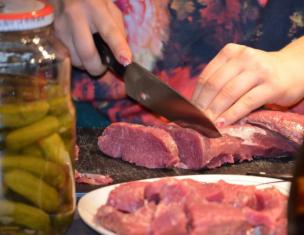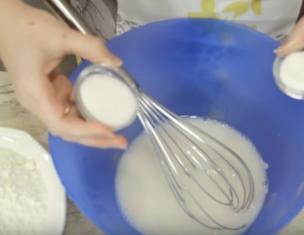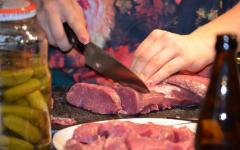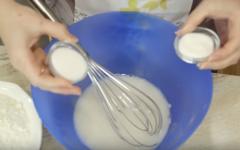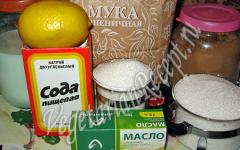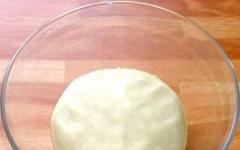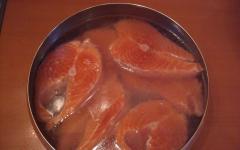
















Properly executed painting of the facade of a building can transform a nondescript wooden house into a beautiful “teremok”, striking in its artistic style. To shape the external appearance of a residential building, a wooden house is painted, the paint for which is selected in strict accordance with the type of material from which the structure is built and the conditions of use - for painting the house outside or inside.
Even a small country house is transformed after painting Source indeco.ru
You can paint a wooden house with different types of paints and varnishes (hereinafter referred to as paintwork materials), since the performance characteristics of paints for exterior and interior work differ. The attractiveness of the building and its durability depend on the quality of the painting of the facade of a wooden building.
Reasons for aging wood in wooden houses
From time immemorial, wooden houses have served people, protecting them from cold, precipitation and wind. At the same time, the building is exposed to negative environmental influences, leading to the aging of wood and the deterioration of its properties as a building material. Centuries-old operating practice has determined the approximate wear period of wooden residential buildings, which does not exceed 80-85 years.
The main natural factors aging the natural wood of building facades are:
direct sunlight, which mercilessly dries out wood fibers. Dried fibers lose their elasticity and strength, change their position, and become prickly. The surface becomes rough, begins to actively absorb sedimentary moisture, burns out and becomes covered with dark spots;
sedimentary moisture, causing deformation and swelling of the material;
This is what will happen if you don’t take care of how to beautifully paint the outside of a wooden house in time; the photo below is not the worst option.

An unprotected wooden surface quickly begins to deteriorate Source lestorg32.ru
temperature changes are the worst enemy of any building material. During sudden cooling, the moisture filling the pores of damp wood freezes, turning into a crystalline state. Ice crystals expand the fibrous structure of the tree until individual fibers break. When drying, the fibers narrow, which, when repeated cyclically, leads to the appearance of cracks;
wood not protected from moist air is prone to rotting, mold and fungal deposits;
wood-boring insects such as bark beetles, which wear away wood and destroy the integrity of the wood structure.
Additional protection for a wooden house when painting
There are plenty of factors that cause aging of wood and premature wear of a house. To preserve wood in its pristine natural state, it is necessary to comprehensively protect the surface of wooden walls with special chemical compounds:
flame retardants - for protection against fire;
moisture-repellent agents - to protect against moisture;
antiseptics - to combat fungi, mold and other biological pests;
insecticidal preparations - to combat the invasion of wood-boring insects.

Such formulations are usually sold in standard containers Source zelmasterplus.ru
A worthy and convenient alternative to the use of protective chemical compounds is painting the facade of a wooden house, the application of which achieves the same effect, similar to the use of a whole complex of various preparations. At the same time, painting the outside of a wooden house performs a wider range of tasks compared to the monofunctions of each protective solution separately, since, along with preserving the quality of the wooden facade, coating with paint and varnish pursues decorative purposes. Using a variety of house painting options, you can significantly transform the appearance of the old facade and the entire wooden structure.
Requirements for paints for wooden facades
There are paints for interior and exterior use. Paintwork materials for external use have a wider temperature range of use and are more moisture resistant. Compositions for painting interior spaces must be safe for people and pets, have no unpleasant odors, and be highly resistant to abrasion.
Initially, the facade of a wooden house was painted with paints for exterior use. When decorating facades by painting became popular, paint manufacturers often began to write “façade” on the packaging instead of “exterior.” Over time, the second name stuck and began to be used even more often than the original one.

Paint “Facade” and “For external use” are the same thing Source karaokerox.ru
The following requirements apply to facade paints for wooden houses:
High adhesive properties to wooden surfaces.
Increased impact resistance and resistance to scratching and chipping, ensuring mechanical strength of the coating. The presence of increased mechanical wear resistance and resistance to abrasive wear from exposure to wind and dust.
Weather resistance, which consists in the ability of a paintwork coating to resist the destructive effects of bad weather and the environment. Here we can also add the requirement for the chemical inertness of paintwork materials in relation to alkalis and acids formed in areas with high concentrations of exhaust gases.
Hydrophobicity, providing water-repellent properties to protect wood from rotting.
Resistance to sudden temperature changes of a cyclic nature.
Lightfastness (resistance to ultraviolet radiation).
Good vapor permeability.
Preservation of elasticity after drying, compensating for microdeformations of facade materials during temperature changes.
Low dirt retention, resistance to repeated washing.
The ability to maintain the brightness of the color for a long time.
Video description
Here's a video of what the paint looks like after 5 years of use at home:
Types of paints for painting wooden facades
When choosing what paint to paint the outside of a wooden house, the following types of paints and varnishes are worthy of attention:
Antiseptic compounds
Capable of impregnating the outer layer of wood to a depth of 4-7 mm for complete protection from the negative effects of the environment, rot, mold and mildew. The industry produces two types of antiseptics:
coating antiseptics - opaque coatings that completely hide the wood texture, while maintaining the surface relief;
glazing antiseptics are transparent coatings that preserve the natural texture pattern.
Acrylate coatings
They have excellent weather resistance and allow the wood to “breathe”. Acrylate coatings do not interfere with natural air exchange through wooden walls. Acrylate paints have high elasticity, which allows the painted layer not to crack when the facade is deformed. In European countries, more than 80% of residential buildings are painted with acrylate paints and varnishes. Acrylate paints of different colors are mixed into homogeneous compositions, which makes it possible to obtain any desired color.
Oil paints
prolonged drying of oil coatings, exceeding 24 hours;
After coating with oil paint, the wooden surface becomes matte.

Oil paints are offered by domestic and foreign manufacturers Source berserkheroes.ru
Alkyd coatings
Endowed with water-repellent properties. However, due to rapid drying (20-30 minutes), the coating penetrates the wood layers to a shallow depth, so alkyd coatings are short-lived. A distinctive feature of alkyd coatings is their ability to withstand low temperatures below 30 degrees below zero.
It is important! Any paintwork needs to be updated periodically. Having decided how to paint the outside of a wooden house, you should know the maximum period during which the applied coating can lose its original appearance and quality:
for antiseptics, the service life ranges from 5 years for glazing compounds and up to 7 years for coating antiseptics;
for acrylate materials – no more than 8-10 years;
for oil paints – up to 6 years;
for alkyd coatings – up to 7 years.
Optimal selection of paint composition for the facade
Purchasing façade paint from leading manufacturers does not guarantee high-quality painting of a wooden house. Exterior paint for a wooden house must correspond to the operating conditions of the building and the condition of the surface being painted. For example, paints produced in Spain or Italy are more adapted to the mild climate typical of these countries, while paints from Finnish or Swedish brands are designed for harsh winters.

“Southern” colors even look more “summery” Source lestorg32.ru
Oil paints are more appropriate when painting the outside of a wooden house over an old paint coating, since wooden buildings were previously painted with oil paints, which modern compositions do not adhere well to. It should be clearly understood that the determining factor when choosing paintwork materials for repair and restoration work is the type of binder, but not the solvent. Therefore, oil or acrylate paints can be applied to old oil paint or alkyd coating without any problems, however, only acrylate paint can be applied to an old coating with an acrylic base.
Alkyd coating options are characterized by high frost resistance; they continue to perform their functions at temperatures below -30 °C.

Properly selected paint retains its properties in hot and cold Source poiskoff.com
Acrylic paints are popular due to their ease of use; they can be diluted with water and applied in any way. When painting, you can get the shade of the desired color yourself. It is enough to purchase white paint as a base composition and special colorants, combining which you get the desired color shade.
Manufacturers of facade paints for wooden houses
The leading brands among manufacturers of facade paints on the Russian coatings market include:
Tikkurila (Finland) is a name that has become a kind of synonym for quality for any paint. The main consumer characteristic of coatings produced by Tikkurila is considered to be excellent hiding power. Tikkurila feels great on wooden surfaces of any configuration.
Alpina (Germany) is one of the leaders in the production of paints and varnishes, successfully competing with other “promoted” brands. The compositions have increased resistance to abrasion and temperature changes. Clients are offered individual computer tinting to create an exclusive façade.
Video description
The video shows a comparison of popular brands of paints and varnishes:
Dufa (Germany) specializes in the production of paints and varnishes that are optimally suited for harsh climatic conditions with cold winters.
Dulux (Netherlands) produces paint in accordance with strict European standards for quality and safety of use. It is a more advantageous option in terms of price/quality compared to other coatings.
Marshall (Türkiye) is a very popular paint in private housing construction, capable of covering a dark-colored base coat. The paint dries quickly and does not drip from brushes or rollers when painting.
Many Russian enterprises produce high-quality paint for exterior painting of wooden surfaces, among which the following stand out:
-
"Yaroslavl colors".
"Optimist".
"Svyatozar".
Russian-made coatings successfully compete with European brands when developers choose reliable facade coatings for budget country buildings and middle-class quality houses.

Domestic manufacturers of facade paints Source berserkheroes.ru
General progress of painting the wooden facade
Painting a wooden house from the outside conventionally occurs in two main stages: preparing the wooden surface for applying paint and varnish and directly applying the paint and varnish coating.
Surface preparation
This is an important point that determines how to paint a wooden house with maximum protective effect. Applying paint to an unprepared wooden surface is extremely undesirable, since conditions for good adhesion of paintwork materials will not be provided and the rules for treating wood against negative biological influences will not be followed. Preparing the surface for painting involves the following activities:
if the building is new, then it is enough to clean the wooden surface from dust and dirt using any available means.
if it is necessary to paint the facade of an old building, then first remove the remnants of the old paintwork and destroy traces of mold;

Old paint is removed as thoroughly as possible Source purpleclover.com
damaged areas of the wooden surface are repaired, all irregularities are smoothed out, cracks are puttied;
nail heads and metal inclusions are coated with a metal primer;
It is advisable to carry out final leveling with a primer.
It is important! Upon completion of the preparatory work, it is recommended to leave the treated surface for several days until completely dry, ensuring high-quality ventilation.
Applying paint and varnish to the prepared façade surface
It is carried out in the following sequence:
the wood is impregnated with a primer antiseptic in order to enhance its protective qualities and improve its adhesive ability;
a finishing coat is applied, consisting of a layer of wood primer and several layers of paint, with a time interval to ensure complete drying of each previous layer.
Painting the new and old surfaces is carried out in the same sequence, but several nuances should be taken into account:
the façade surface of the old building must be painted with the same type of paint and varnish that was originally applied;
Video description
The process of painting a house is clearly shown in the video:
When painting the exterior wooden surfaces of a residential building, it is recommended to “listen” to some advice from experienced craftsmen.
The paint is applied only to a dry surface. When painting in several layers, the interlayer exposure is observed, which for alkyd compositions is 24 hours, and for water-based ones - from 2 to 12 hours.
Paintwork materials are applied in the longitudinal direction relative to the fibers.
The consumption of façade paint will be noticeably reduced if the surface is primed.
On our website you can get acquainted with companies specializing in paint and varnish materials, among the houses presented at the exhibition is Low-Rise Country.
Conclusion
The facade of the building is the face of the building. By the appearance of the facade, one judges not only the quality of a residential building, but also the tastes of its owner. Therefore, painting the facade should be considered one of the main measures to shape the appearance of the building and ensure its readiness for many years of operation.
A wooden house is an environmentally friendly and comfortable housing, which is characterized by durability and reliability, aesthetic appeal and a cozy indoor environment.
But do not forget that wood is a living natural material. Therefore, it is susceptible to negative environmental influences. These are high humidity and dampness, ultraviolet rays and insects, temperature changes and other harmful factors. During use, the wood gradually ages, darkens or turns yellow and loses its original appearance.
Special protective and decorative compounds for treating walls will help preserve wood. In this article we will look at how to paint the outside of a wooden house. Painting the external walls of a wooden house is a mandatory stage in the construction and finishing of a country log home!
It is necessary to paint a house not only after construction and shrinkage, but also during operation. Experts recommend painting wooden buildings once every 5-8 years, depending on the type of paint and varnish materials, and it is advisable to treat an old house more often.
Which painting products to choose
Today, manufacturers offer various paints and varnishes. For external wood processing, resistant and rough compounds are suitable. Let's look at which ones are best to use for a log house.
Antiseptic varnishes come in glazing (transparent) and covering (opaque) varieties. The first type preserves the natural color and emphasizes the texture of the wood, while the second will help achieve the desired shade and shine. Such products penetrate deep into the wood and protect the material from rot and mold, the negative effects of water and humidity. When choosing, please note that coating compositions will last 6-7 years, but glazing varnish will have to be renewed every 4-5 years.

Acrylic (acrylant) paints are the most popular products among owners of country houses. They are best suited for natural wood as they are absolutely safe. Such paints allow the wood to “breathe” and guarantee good air exchange. The acrylic composition creates an elastic, dense coating that protects the wood from moisture, cracking and fungus.

Acrylic paints are expensive, but they create a durable and reliable coating that will last a long time. You won’t have to renew your paint more often than once every 8-10 years!
Oil paints are well absorbed and penetrate deep into the wood structure. They effectively protect log walls from dirt and moisture. But today such products are losing popularity because they take a long time to dry. In addition, over time, painted wood changes color and shade, and yellow spots appear on the surface. To avoid this, you will have to repaint more often than every four years.

Yacht varnish is best suited for regions with high rainfall and high humidity. It provides reliable protection against temperature extremes and moisture. This varnish does not fade and prevents the appearance of yellowness on the surface. The product is durable, but when painted it emits an unpleasant odor.
Using wax or stain is an old, tried-and-true method for painting your home. Wax is a natural and safe product that will not disturb the environmental friendliness of the wooden structure. It is deeply absorbed into the material and effectively protects log walls from dirt and moisture. After waxing, the surface will become translucent with a matte shine.
Stain is the cheapest and most accessible option for treating a home, both outside and inside. It will also protect the tree from pests and fungus, while preserving the pattern and color of the logs. But after staining, you must apply varnish to enhance the properties and increase the service life of the material.

In addition to the type of paint or varnish, it is important to choose the right color. You can choose transparent compounds to preserve the structure and color of the log, choose a darker or lighter shade, matte or glossy sheen. In addition, today there are also means for painting a wooden house with colors that have nothing to do with the color of the wood.
You can paint your house purple, green, red and any other colors. It all depends on your preferences. Designers recommend using warm shades in northern latitudes and cold regions of the country. And in warm regions, on the contrary, use cool colors.
If you cannot find the right materials, turn to professionals for help! Experienced experts of the MariSrub company will select high-quality products and calculate the amount of paint, reliably and quickly paint a wooden house, bathhouse or gazebo. Let's find out how to properly paint a wooden house.
The best facade paints for wood
| Brand | Description | Advantages | Price |
| Tikkurila (Finland) | The most popular products that have received positive reviews from both professional craftsmen and ordinary owners of wooden houses | High water-repellent properties; a wide range of; good frost resistance | from 600 rubles for 0.9 l |
| Senezh (Russia) | High-class antiseptic and renewing compositions suitable for baths, homes and gazebos, with a large selection of colors (16 colors and shades) | Difficult to wash out and compositions with a service life of 10 years; protection not only from moisture and pests, but also from the spread of fire during a fire | from 240 rubles for 0.9 kg |
| Drevoplast (Russia) | A durable acrylic emulsion that creates a durable decorative coating on the surface of the walls and gives the effect of “liquid plastic” | High resistance to precipitation and humidity, easy application, long-lasting protection | from 350 rubles for 0.9 kg |
| Tex (Russia) | Universal inexpensive paint for exterior work, which creates a durable polymer film on the surface of the walls | High vapor permeability, resistance to light and ultraviolet radiation, fits well on walls | from 300 rubles for 0.9 kg |
| Pinotex (Estonia) | Polymer-based decorative products for exterior painting of the facade of a house, gazebo or bathhouse, fences and fences, wooden canopies | Protects against mold and moisture, fungus and insects, withstands sudden temperature changes | from 490 rubles per 1 l |
| Olympus (Russia) | Elastic emulsion based on flax oil for new and old surfaces, suitable for wooden facades, garden furniture, ceilings and floors inside the house | Versatility; strengthens wood and does not crack, protects against moisture and insects, mold and mildew |
from 200 rubles for 0.9 kg |
How to paint a house
- The initial stage is preparing the walls. Remove dust and dirt from the logs, level the surface if necessary;
Then a primer is applied to the surface. It will protect the walls from mold, blue stains and fungus. Without a primer, after two years the house will have to be painted again; - After the primer has completely dried, proceed to painting. Remember that you can only paint dry wood and in dry weather! If you are using oil paints that take a long time to dry, it is advisable that there is no rain in the next few days. Therefore, before the procedure, check the weather forecast;
- It is better to paint with a roller and brush, since when using a spray gun it is difficult to obtain a perfectly even, smooth and painted coating, especially if you have little experience in painting;
- Before coating, thoroughly stir the paint composition;
- The paint is applied with a roller evenly in two or three layers. It is better to use a brush for painting hard-to-reach places. Some companies produce special paints with enhanced protective composition for ends and corners, since these places are most susceptible to the negative effects of moisture;
- Apply each new layer only on the dried previous layer. This takes 3-4 hours; Stir the composition of the paint and varnish periodically;
- The last layer of paint is applied from top to bottom in a thin layer;
- Finally, the paint can be coated with clear varnish. This will consolidate the result, increase the service life of the coating and better protect the wood. But you can get by with just one paint.

How to paint an old house
Remember to renew the paint at intervals depending on the type of paint or varnish. Before painting, it is important to carefully prepare the old house for the procedure. When repainting, experts recommend using the same type of product that was used previously.
After purchasing the necessary materials, the old paint coating is removed from the surface of the logs and dirt is removed. Mold is removed with a special solution and the damaged areas are additionally treated with an alkaline detergent. It is better to replace old, crooked and rotten boards with new ones.
Sand the walls if necessary. How to properly sand walls, read the link http://marisrub.ru/uslugi/rabota-so-stenami-doma/shlifovka-sten. After the preparatory work, painting is carried out according to the same scheme as painting a new wooden house. If you have any problems painting your house, contact the MariSrub company!
It seems that homeowners are no longer happy with a light and neutral exterior color paired with a darker roof shade. In 2019, there is a clear trend of demand for more unusual and bold colors of houses in the private sector. However, the desire to stand out from others does not always lead to the desired “Wow” effect. In this article, we have collected 35 photos of successful examples of painting houses and combining colors of the facade and roof with useful tips for those who are planning to update the appearance of their home this year . Enjoy reading!
Here are some general tips for choosing a color for the facade of a house before moving on to an overview of popular shades and color combinations of the facade and roof:
- If you want to paint your home an unusual color that you love but don't know what to pair it with, then simply choose a shade that is a couple of shades lighter or darker than your base on the color wheel. And to make such a simple solution unforgettable, paint the front door some bright and contrasting color, as in the following photo.
Also read:
2. Are there natural materials in the facade of your house that do not need painting? Then know that if they have a cold texture (concrete, slate, etc.), then it is better to combine them with bright colors of facades, and vice versa. Thus, concrete today is combined with orange exterior walls of the house, and warm wood and stone are combined with elegant gray facades.

3. The monochromatic color of the facade can become much more interesting if you highlight its individual details with white or another suitable color. Thin gables, window frames and other small elements can be very expressive decorations for the exterior of your home.

4. Contrasting (in relation to the facade walls) shades are ideal for painting the base, canopy over the porch, bay windows and other protruding parts of the facade. Just make sure they have interesting enough shapes that are worth highlighting.

5. Surprisingly, bright and bold colors are best suited for unremarkable or even repulsive facades, because... distract our attention from low quality details and design. At the same time, if your house has beautiful bas-reliefs or other attractive elements, then the color of the facade should be gentle or neutral.

6. If your house is made of stone, wood or other unpainted material and you are looking for a color to paint the roof and other exterior elements, then try to find it in the facade material itself. This could be brownish-green specks on the stone, or darker shades of “knots” in the wood. Nature is the best master at creating stylish color combinations.

7. After you have roughly decided on the color of the facade, try painting a fairly large piece of drywall, plywood or whatman paper. Apply this sample to the outside of your home and stand back to see how it looks. Any tone may look gorgeous in someone else's photo, but in reality it will not harmonize with the environment of your home. An extra check never hurts! Based on its results, it may well turn out that you need to dilute the paint a tone lighter or darker.
Color combination for house facades and roofs - 35 photos
If you don’t have a specific favorite shade and you need ideas on what façade color to choose, then especially for you, we provide an overview of several of the most popular shades for the façade of a private house in 2019.
The most fashionable facade color is sage
This soft light green shade looks great against any background and pairs well with both bright and dark tones. In the next photo of the facades you see examples of its combination with red-orange and dark blue “Navy”. Both houses are made in the same style, have two floors, siding and the same window shape, but the details of different shades against the general background make them look completely different! Which combination do you like best?



Elegant gray house facades
No matter how versatile the shade of sage is, it cannot be compared with gray. By the way, gray tones are now in demand in the interior decoration of private houses. Below we show several photos where gray is used as the main color of the facade.


Facade finishing in luxurious red color
Deep ruby red shades, as well as last year -, are loved by facade designers not only for their luxurious appearance, but also for their ability to combine with the green plants that surround most private houses. This is because red and green are opposites on the color wheel, and therefore provide the greatest contrast to each other. If your home has an interesting shape that's worth highlighting, paint it a color that complements the surrounding landscape.



Combination of gray and brown colors for the facade of the house
Gray and brown are versatile earthy shades that are guaranteed to look good against any background. The combination of these colors is no less suitable for the facade of the house and the roof than the fashionable gray-brown color, which is also called “taupe”. The photos below prove it.




Other beautiful colors of house facades (photos)
Finally, we will present some more successful color combinations for the facade of the house and the roof, including houses in blue, yellow, black, etc. We will be grateful for any comments and opinions on this article!
Also read:







You dip your brush into it and create to your heart's content. But it's not that simple. Any professional will tell you that when painting a house, certain technology and painting rules are important. Everyone has probably noticed: for some, a painted house lasts for many years and the paint is like new, while for others, the house loses its appearance after just a year or two. So what is the secret and how to paint a wooden house correctly?
Wood, as a living and natural material, is very susceptible to aging. The aging and destruction of wood depends on many factors, but the most important enemies of wood are UV radiation, water and humidity, as well as fungi.
Sunlight, together with water, temperature, oxygen and other external influences (dust, dirt, fungi, sulfur compounds) destroys the surface of the wood, as a result of which it turns gray and becomes rough, and its fibers stand upright. This surface gets dirty easily. Moreover, such changes can be seen literally within a few weeks. Water first causes the wood to swell, which, when dried, causes a state of tension, which eventually leads to cracking. In addition, water stimulates humidity, and humidity in turn, especially at elevated temperatures, causes the growth of blue fungi, mold and rot. Mold fungi grow only on the surface in the form of dark spots and have a heavy and unpleasant odor. And blue fungi grow in the fiber of wood and cover its surface brown, blue-gray or almost black. Blue stain fungi and mold do not destroy wood or reduce its strength, but only cause aesthetic damage, making the appearance of the surface unsightly. But rot fungi are already destroying the wood and causing structural damage inside it. They can destroy wood cells from the inside and corrode cellulose, as a result of which the strength of the wood is significantly deteriorated and the wood becomes unsuitable for use. We should also not forget about bark beetles, which crawl out after a 2-3-year larval stage. In addition to all this, it must be taken into account that the atmospheric loads on a wooden surface in the coastal zone and in open spaces are especially high, and on the southern and western sides of buildings they are five times greater than on the northern. Thus, by carefully studying the causes of negative impacts on the tree, we can better eliminate and counter them.
1. Choose paints and impregnations from well-known companies.
2. Preliminary surface preparation. This has an important impact on the final result and should never be neglected. Careful surface preparation improves paint adhesion to the surface, etc. The service life of the finished coating is significantly increased.
First, remove dust and foreign matter from the surface. It is better to do this by rinsing the surface with water using a garden sprayer and a brush, because... water collects dust better. If there are already areas affected by mold and blue stains on the surface, then they need to be treated with a special anti-fungus and blue stain compound, and then rinsed with water. If there is resin in the places of knots (this is typical of coniferous wood), then you need to remove it with a metal spatula and then treat it with a compound for knots. Nail heads and other metal parts need to be coated with an anti-corrosion primer. It is a good idea to leave the surface prepared in this way to dry for one or two weeks, covering the surface with plastic film (in warm weather, do not forget to open the film) and be sure to leave room for ventilation. By the way, if we have a suspicion that the tree is not completely dry, then we will dry it for at least a month, covering it with a curtain of film in rainy weather, and removing this curtain in dry weather. If it is not possible to dry the tree at all, then we will cover it as is with a tinted primer and leave it until better times, when it will be possible to dry the tree.
3.Choice of paint.
Antiseptics penetrate the wood to a depth of several millimeters and protect the wood surface from the effects of atmospheric loads, rot, mold and blue stains. Antiseptics are glazing (translucent) and covering (opaque). Glazing (translucent) antiseptics preserve the wood texture well and at the same time give the wood a certain color tint; they preserve the beauty and pattern of wood better than other paints and varnishes. Covering (opaque) antiseptics completely cover the wood texture while maintaining visible relief of the wooden surface. Oil paints absorb well into wood and have excellent weather resistance, they are good at preventing water from penetrating the wood, but they dry slowly (seven hours to a day or more). In addition, oil paints tend to slowly matte and change color over time, which is especially noticeable in bright and dark shades of paint.
Acrylate paints are extremely weather resistant. Compared to oil paints, they retain their color and shine much better and, in addition, have good vapor permeability (they “breathe well”). The acrylate present in paints gives them excellent elasticity. Acrylate paints live in time with the deformations of wood and do not crack. Regarding service life, let’s say that the average service life (after which it is recommended to renew the surface):
- for glazing (translucent) antiseptics it is 3-5 years.
- for covering antiseptics 5-7 years
- for oil paints 5-6 years
- for acrylate paints from 7 to 10 years.
Varnish does not allow moisture vapor to pass through easily, so it should not be used for exterior finishing of a wooden house. Try to choose paint that applies a thick layer and hides defects
4. Application rules. Regarding the technology of applying paint and varnish to wood, we will say the following: for many well-known manufacturers of paints for protecting wood from the outside, the technology of applying paint to wood is divided into two stages. The first stage is the application of a primer antiseptic. Primer antiseptic plays an important role in protecting wood; it significantly slows down the effects of moisture, rot fungi, blue stains and mold. Neglect of priming with such an antiseptic leads to global consequences; the service life of the entire paintwork is significantly reduced. The second stage is the application of the finishing coating, which can be used as glazing and coating antiseptics, oil and acrylate paints. So, when the surface is prepared, we apply one layer of primer antiseptic, then, when the surface is dry (usually the next day), we apply 2 -3 layers of topcoat paint or antiseptic, drying each layer thoroughly.
Moreover, if we follow a few simple tips below, the service life of the coating we apply will be maximum, and the appearance of the house will delight us for a long time.
- mix the paint thoroughly before and during painting, otherwise the gloss and color of the paint coating on the surface may be uneven. - do a test paint on a small area of an unnecessary board and check the correctness of the chosen color.
- it is best to paint with a brush, because... This is the highest quality painting method. At the same time, try not to apply too thick layers, because... You risk getting uneven color and shine on the surface being painted.
- if possible, tint the primer in a color that is closest to the future coating.
- do not paint under direct exposure to sunlight, this will lead to undesirably rapid drying. Therefore, do not carry out painting work in hot and bright sunny weather, or if precipitation (rain, dew) is expected. The most favorable weather for painting is cloudy, windless and warm. Always apply paint and antiseptic in the longitudinal direction.
- the ends of boards and logs are the weakest points, through them water is especially easily and quickly absorbed into the wood, so they need to be especially carefully covered with several layers of both primer and coating material.
To properly paint a wooden house, you must first clean off the resin in those places where it appeared using a solvent and fill the gaps between the knots and the wood.  5.How and with what to properly paint a wooden house (outside)?
5.How and with what to properly paint a wooden house (outside)?
Previously painted wooden surfaces. If we see that the previously painted surface has faded, has a faded appearance, is covered with mold, the paint on the surface is peeling and other similar defects, then it’s time to think about updating the paint coating. A new coat of paint will significantly improve the appearance of the house, and at the same time you can also change the color of the facade itself. But before we begin the renovation, we must decide for ourselves what we want to get as a result? Indeed, often the very condition of the wooden surface limits us in choosing paint. It is worth thinking about repairing not the entire facade, but its individual parts, for example, the southern and western walls of the facade, which experience the greatest atmospheric loads and, accordingly, more often need repairs than other walls . Sometimes a good solution is selective repair of individual places or high-quality repair of one (the most worn) wall, with the intention of repairing other walls next season. If the wooden facade is in good technical condition and does not have gross structural defects or damage, it can simply be updated by repainting it in the same or a different color. In the case of repainting, when choosing a new paint, it is better to adhere to the following rule: for repainting, use the same paint or the same type of paint that was previously painted on the surface. If we do not know what paint the surface was previously painted with, we will try to determine the type of paint previously applied. Types of paints can be determined visually. Acrylate paint has a leathery surface and chalks less and later than oil paint. Acrylate paint usually cracks in the direction of the wood grain, while oil paint has checkered or transverse cracking in the direction of the wood grain. You can conduct a simple experiment, try to roll up a small piece of paint. If the l/c film remains intact, then this usually means acrylate paint, and if the film breaks with a bang, then it is most likely oil paint. Glazing antiseptics also wear out over time and their film becomes thinner. If we see a glossy film of antiseptic, then the surface can be repainted with the same antiseptic of a richer or darker color or with oil-based paint. If the antiseptic has completely faded and does not form a film, then the surface to be coated can also be painted with acrylate paint.
We paint the old surface covered with oil paint with oil paint or acrylate paint (after having previously cleaned the surface with a wire brush to the wood). We paint the surface covered with acrylate paint with acrylate paint or, if you really want, with oil paint (after cleaning the surface with a wire brush to the wood).
Preliminary preparation is important during repairs; how thoroughly it is carried out, the better and longer the coating will last. In such cases, the surface to be painted is usually cleaned of hanging scraps of old paint, dust, dirt, resin and foreign matter with a brush or scraper and washed with water. Mold is removed with a special solution. For better adhesion of paint on the surface, it is recommended to degrease the surface with alkaline detergents. Old sheathing, as well as rotten, crooked and cracked boards must be replaced with new ones. If you need to remove old paint, then remove it mechanically (sandblasting, scraper or metal brush) or chemically (using special compounds). Chemical removal of lacquer coating better preserves the wood texture, but the process of chemical removal itself is difficult and slow, and to use it on large areas (in this case, facades) you need to be very patient. Chemical removal of old paint is used only when the surface to be cleaned must be cleaned very thoroughly or the condition of the wood does not withstand sandblasting. However, the end result of chemical removal is exceptionally excellent. In addition, it is necessary to do a trial removal of old paint. If you need to sand, then sand the wood. Next, we simply proceed according to the above plan. If we do everything as expected, we will get a good façade coating that will serve us for many years.
It is best to paint with a brush rather than a roller, as this is the highest quality painting method. However, you should not apply too thick a layer, as this may result in uneven color and shine on the surface being painted.



